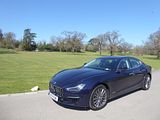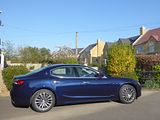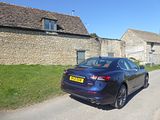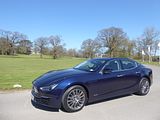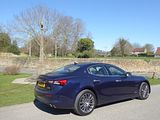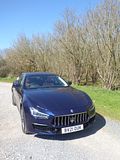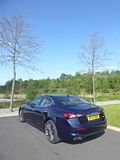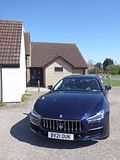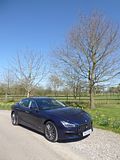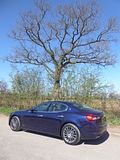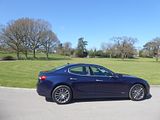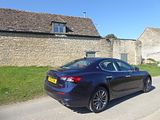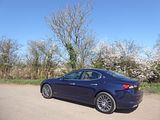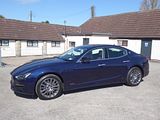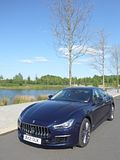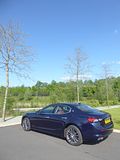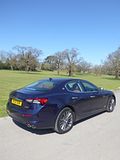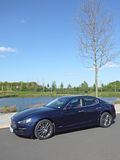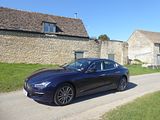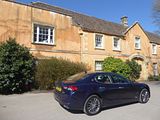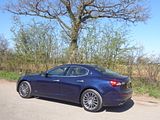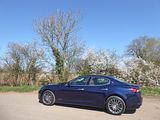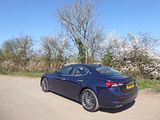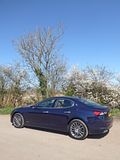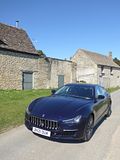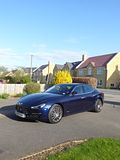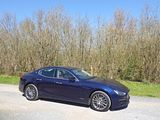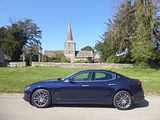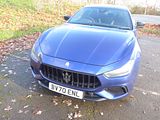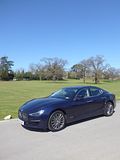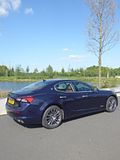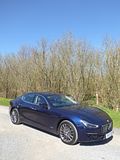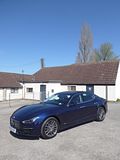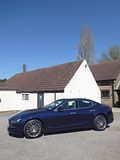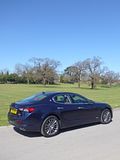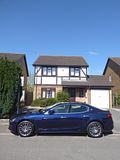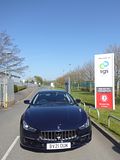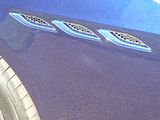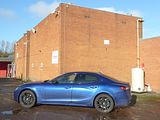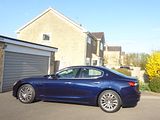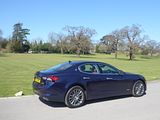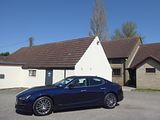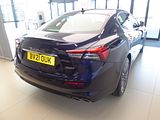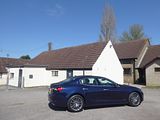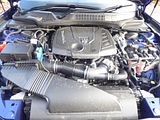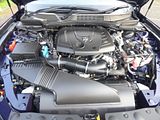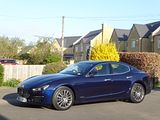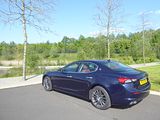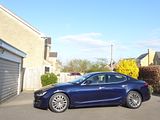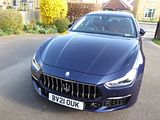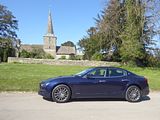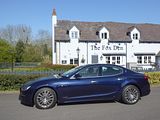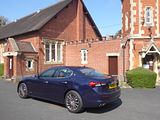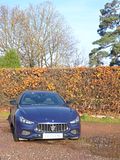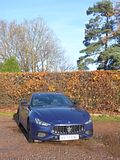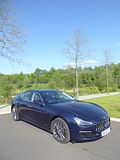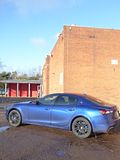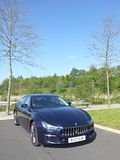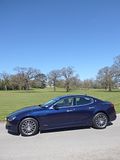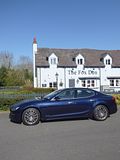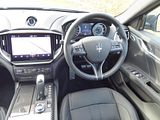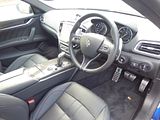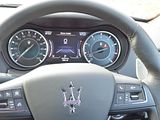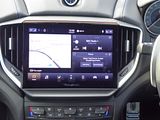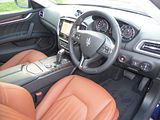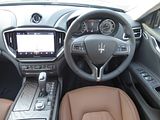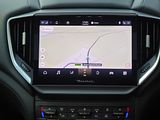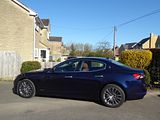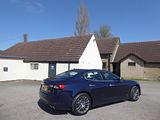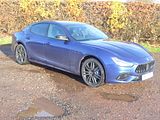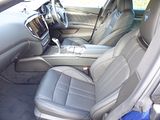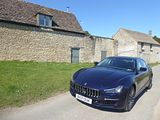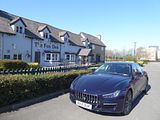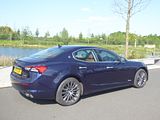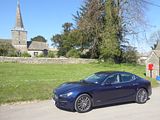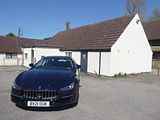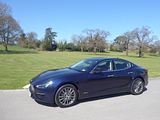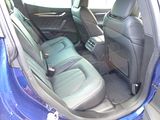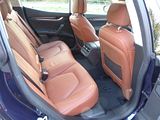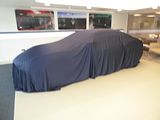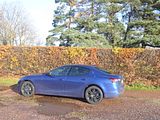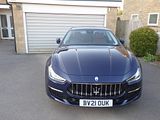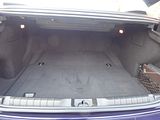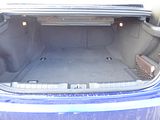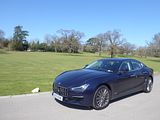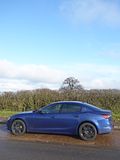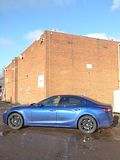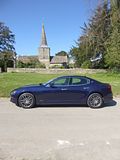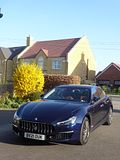It used to be the case that the first we knew of a new car was when a grand unveiling was accompanied by an immediate appearance in the local showroom. Those days are gone, with a carefully controlled drip feed of scoop photos, officially leaked photos, first passenger rides of a car that is far from final and well disguised, the official reveal, the first drive, the longer drive and so on, all aimed at maximising the amount of publicity that a manufacturer can achieve from a single model launch or even the debut of a new variant or a facelift. So the existence of this car, the hybrid version of Maserati’s Ghibli was well known long before its formal launch. During 2019 I paid particular attention to what was being said, and was especially eager to understand the dates, as the lease end date on my Ghibli Diesel was approaching and another Maserati was one of only a couple of cars that were on my real “short list”. I asked my supplying dealer what they knew, only to find out that they were about to go Ferrari only and so had not been made aware of future Maserati product plans. The usual rumour sources continued to suggest a launch at Geneva 2020 with availability in the summer. Perfect timing for me, or so I thought. Of course, the Geneva Show 2020 was cancelled at the last minute thanks to the Covid pandemic and with it a lot of planned launches were delayed. With plans for an on-line rather than physical launch for most of the cars that had been intended to see their premiers in Geneva hastily arranged, a facelift to the Ghibli and the launch of the new Hybrid model, as well as a range-topping Trofeo with a thunderous V8 engine did finally happen in July 2020. On paper, the new Hybrid looked to be everything I was hoping for, in terms of spec, likely pricing and even, hopefully, availability. Quickly it became apparent that production dates would slip, though, but as we were all in that post-lockdown world where no-one was travelling much, my first move was simply to extend the lease of the Ghibli I had by 6 months, and see what then transpired. As the remainder of 2020 ticked by, and the country entered a second lockdown, the next course of action remained unclear, and the fact that there had been no further press coverage, let alone a first drive of the car did not augur well. But at the start of December, I got a phone call from my now nearest dealer, Graypaul in Solihull, telling me that they had just received a Ghibli Hybrid, and had registered it, so it was available for me to come and drive just as soon as I wanted. With all the signs suggesting a third full lock-down was on the cards, I wasted no time in booking an appointment for the following Saturday and then made plans to be at the dealership for enough of the day to test the car as thoroughly as I was going to be able to do on a winter’s day when he country was still unsure quite what activities were possible and which were still off limits. Sure enough, when I got to the dealer, there was a newly plated Ghibli Hybrid in GranSport trim, painted in Blu Emozione, the brightest of the three shades of blue that Maserati offer, ready and waiting for me.
The launch of the Hybrid model coincided with a mid-cycle facelift to the entire Ghibli range, and this was obviously my first chance to see what had changed. Like most facelifts these days, it takes a trained eye to spot most of the alterations. The most obvious were the rear lights which certainly do look different, being that bit slimmer and with different layout of the individual lights in the cluster. The front end saw some changes too, going beyond those made in 2017 when a much large grille had appeared on the car. The Hybrid car sports blue trim around the wing vents and around the badge on the rear C pillar, whereas you can tell a Trofeo from its red colour swathes in these places. Inside the most significant alteration was a new infotainment unit, larger and with new graphics and menu structure, with the removal of the usual control wheel and buttons from the centre console. The instruments sported new graphics and the gear selector – one of the few items to draw pretty universal criticism for its recalcitrance, was revised. Beyond that, everything else that differed in this test car was down to the fact that this was in GranSport trim, one of three trim levels which had been introduced in the 2017 model update.
Maserati chose to go down the mild hybrid route for the Ghibli. That means that the car does not run solely on battery power unlike some other hybrid cars. Rather it uses a 48 v battery, that sits under the boot floor, as well as a belt starter and an eBooster unit that gives the powertrain a zap of performance at low revs, as well as better economy and most importantly, lower emissions than would otherwise be the case. The engine is a 2.0 litre unit which is closely related to the one found in the Alfa Giulia and Stelvio, though Maserati are understandably coy about just how much it shares. Including the battery boost, power output is a healthy 329 bhp, which is a big gain over the 276 bhp of the outgoing diesel model, and this is achieved with a CO2 rating of 190 g/km, which is what the diesel produced. With an extra 53 bhp, I was expecting to notice a difference when I drove the Ghibli Hybrid, and I certainly did. Gone first of all, is the rather evident diesel rattle which was always a feature of the diesel on start up (it quickly abated) with the Hybrid model sounding very quiet, though once I was free of the traffic and heading onto the M42, there was quite a pleasing roar from the engine as I accelerated away. The car seemed to gain speed quickly, and then I looked at the speedo ad saw that I was travelling somewhat faster than the law permits and that the M42’s speed cameras would accept without reminding me of their presence. As before, there are multiple driving modes and putting the car into Sport only improved things still further. The noise whilst accelerating was better, though once at a cruising speed, actually there is next to no noise at all, this being a very quiet car. A 70 mph, the engine is spinning at just 1800 rpm, so it really is not doing a lot more than a fast idle. But when there is a need and an open road, acceleration is strong and the car will perform far better than you might think a 2 litre 4 cylinder unit in a large and heavy car would do. There is an 8 speed automatic gearbox, standard on all Ghibli models, and it does a very god job at seamlessly finding the most appropriate gear for what it thinks the driver is about to do. GranSport models have standard paddles. These are large and I found them a bit of a nuisance, if I am honest (not a fan of paddles, generally!), but for those who want to do their own gearchanges they are a must. I only drove the GranSport test car on a circular route from Solihull, down the M42 and M40 to Warwick and then back o country A roads, which would give me a reasonably representative test of the sort of roads that I use everyday, but this 35 mile journey was not really enough to get anything meaningful fuel consumption data, though the trip computer in the car was telling me that on this little trip, the average was around 39 mpg. Subsequent experience with the Hybrid model has shown that it is as economical as the diesel, and that it is at its best on long motorway journeys where an excess of 40 mpg is a common occurrence. There is an 80 litre fuel tank which means that a range of over 600 miles can be achieved.
In other respects, this Hybrid model felt very similar from behind the wheel to the Diesel that I have had for 4 years and 70,000 miles, though in fact there have been changes, with a new electric power steering system, EPS, replacing the former hydraulic setup. Like so many cars that have made this change, it has been introduced to allow the integration of new Advanced Driving Assistance Systems (ADAS) like Highway Assist, Lane Keeping Assist and Active Blind Spot Assist; together with Adaptive Cruise Control and Traffic Sign Recognition. These features are all available in the Driver Assistance package. The steering is not overly light, though no-one is likely to call it heavy, which means that the car is easy to manoeuvre in parking situations, but there is still decent feel when out on the open road. The Ghibli has near 50/50 weight distribution and the combination of this and the carefully designed independent suspension means that it handles well. There is lots of grip and body roll is kept to a minimum. It is a big car and so is not as agile, as say, an Alfa Giulia, but you probably don’t expect it to be. The GranSport comes as standard on 20” 40 profile tyres, which is an inch larger than those on my Diesel, and those are an inch larger than the standard wheels on the entry level car. I’ve now driven cars on all three sizes and there did not seem to be any real penalty in going for the largest ones (until you get the bill for replacing them, of course!). The brakes are powerful, and although in 4 years I’ve never had the occasion to give them the ultimate test, I don’t believe they would be found wanting. Visibility whilst on the move is generally good, but this is a big car and so parking it is not that easy. Although there are parking sensors fitted as standard front and back, quickly regretted not paying extra for the rear camera, as the car goes a long way back behind you and you can’t easily judge just where it ends. You also need to remember that there is a long front to the car, too.
The overall design of the interior has not changed during the life of the Ghibli, and why would it? Open the door and look in, as so many people have done with my car and the comments are frequently that this is a truly lush cabin and for many this could be one of the car’s strongest draws. An interestingly sculpted, leather-sheathed dashboard, sumptuously upholstered seats and an aura of fine Italian craftsmanship make for a particularly inviting environment, as has long been the Maserati way. GranLusso and GranSport cars have more leather in use, with this covering all the dash, and on the GranSport, there is some blue stitching, as well as the Nerissimo features of the test car which meant lots of carbon fibre trim and extra black. I have to say that not all of this was quite to my taste, but there are solutions to this which we will come to. The press continue to complain about some interior component quality, and I continue to wonder which unspecified items they are objecting to, as to my eyes this is a nicely presented interior which certainly feels special. The instrument cluster is shaped as before, but the two main dials have been changed with perhaps a more modern graphic in use. The digital display between them, selected by using buttons on the right hand steering wheel spoke remain, and these show trip data as well as service needs, tyre pressures and any warning messages. There is still a single column stalk, with wipers operated by twisting the end. Lights are on a rotary dial on the dash to the left of the wheel. Top centre of the dash is a lovely analogue clock, something of a Maserati tradition. Beneath this is the newly revised infotainment screen. This has a slight curve to the bottom and it uses new graphics and a new menu structure. It is actually more different that you might think. The Ghibli now features the new Maserati Connect program, which enables a constant connection with the car: the information exchange continues when on the move, to improve the services offered to the driver. As well as updating the software packages, the system performs checks on the car and monitors the Safety Security services in emergencies. The Maserati Intelligent Assistant multimedia system is latest-generation, based on digital inputs from Android Automotive, software that delivers an innovative User Experience fully customisable to the driver’s personal preferences. The multimedia system’s HD screen, with new graphics, more user-friendly and without surrounds, is increased in size from 8.4” to 10.1”. Most of the changes are welcome, though the removal of some of the selection buttons in the centre console means that to change radio selection you either need to use the screen itself or the repeater buttons on the back of the steering wheel, which are sometimes a bit reticent in operation. The navigation system is good, and the new feature which shows average speed through a camera controlled section is really useful. There are the same buttons for the dual zone climate control as before, set below the screen. The GranSport spec includes heated seats, something I did not specify (as a cost option) on my car in 2016.
The seats are very comfortable. They all have fully integrated headrests. The seats on the GranSport, in keeping with the name, are a bit sportier. Unlike my Diesel version, there is full 12-way electric adjustment, and it would take someone of unusual proportions who would fail to get comfortable. You also get seat heating on the GranLusso and GranSport trims. The steering column also has electric adjustment.
Although this is a big car, there is perhaps not quite as much space in the back as you might be expecting. There are three rear belts but the reality of a sizeable central tunnel and a console unit which extends well back mean that a middle seat occupant will feel a bit squeezed. Leg room will depend on how far back the front seats are set. I have the seat well forward leaving a lot of space behind e, but front seat occupants with longer legs will not be quite so understanding to those in the back. There is a drop down armrest with cupholders in the upper surface and there are pockets on the back of the seats and on the doors.
The boot is a good size. It is long from front to back and wide, and the rear seat backrests d rop down for extra length if needed. There is a useful net at one side to hold odds and ends and there are retaining hooks for securing smaller items. The battery system uses what space there had been under the boot floor, where a space saver tyre could be fitted and where the diesel cars had their AdBlue tank. Most should find the available boot space sufficient, though. Inside the cabin there is a good size glovebox, some relatively slim pockets on the doors, and a very deep cubby under the armrest which will take half a dozen standard size bottles of water as well as a couple of cupholders under a lidded cover in the console where you will also find another small lidded area. In front of the gearlever there is another lid and behind this there is wireless phone charging.
Maserati expect the Hybrid, which takes over from the Diesel model, to take a large percentage of Ghibli sales. UK buyers do still have the possibility of a 3 litre V6 petrol model, which generates 345 bhp and there is the new V8 powered Trofeo at the very top of the range. The more potent 3.0 V6 S model is no longer available in the UK. Some markets get cars with an all-wheel drive system, but all UK market Ghibli cars are rear wheel drive only. The Hybrid is available in three trim levels, as was its predecessor: the regular model, GranLusso and GranSport. Both gain quite a few features as standard which are cost options on the entry level car, such as adaptive LED headlights, 12-way electric adjustment for the seats with two memory settings, an electrically adjustable steering column and more leather on the dashboard and soft close doors. The GranLusso features chromed grille finishing, as well as the badges on the side of the car. The GranSport comes with a Sport-specific bumper with Black Piano inserts, GranSport badges on the wings, optional black grille finishing and 20” Urano machine-polished alloy wheels with red calipers as well as sport seats and electronic skyhook dampers. An optional Exterior Carbon Package for the GranSport is something that will tempt some (though not me!). This includes door handles, exterior door mirrors, B- and C-pillar covers, front splitter and the rear spoiler all finished in carbon. As with all cars at this price point, there are plenty of options, and you can choose between a number of – rather sober, it has to be said – colours for the outside, and have the choice of several different finishes for the trim inlays. The Radica open pore wood remains my favourite, but others will prefer carbon fibre or gloss black.
Maserati have sold over 100,000 Ghibli models since its launch in 2013. That is a drop in the proverbial compared to the German rivals of this size, so this remains something of a niche choice. Many of the press reviews are not entirely convinced by the car, as their priorities lie with facets that Maserati have chosen not to prioritise. This is not some out and out brash executive car with an unbearable ride – which is exactly how the most sporting looking Audi, BMW and Mercedes models come across – but rather it is a car that majors on style and comfort, but which actually is not wanting when it comes to time behind the wheel. It’s a formula that has worked well for me in the last four and a bit years. So I was delighted to discover from a short test that the new Ghibli Hybrid was everything I was hoping for. It goes well, notably faster than the Diesel model and solves the twin problems with the Diesel of the need for one refill of AdBlue between major services (a pain as it was effectively impossible to do the job yourself) and the diesel rattle on start up. The cosmetic changes endow the car with a fresh look and the new infotainment system is a definite improvement. It was very tempting to sign on the dotted line there and then, but there was one more car I needed to test out before making a final decision. A report on that one will ensue shortly.


